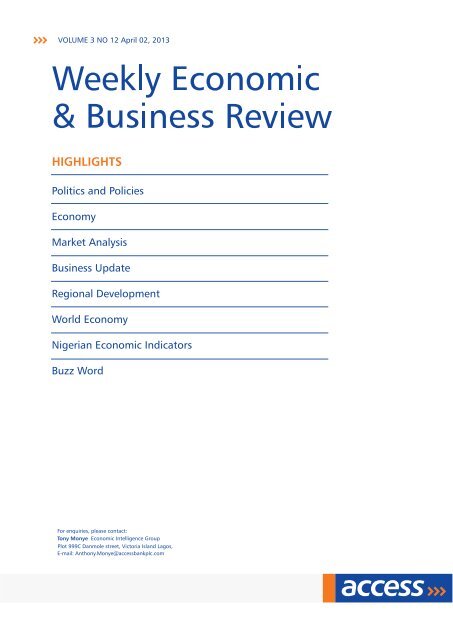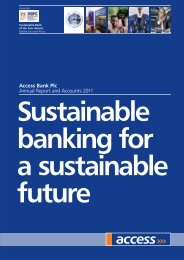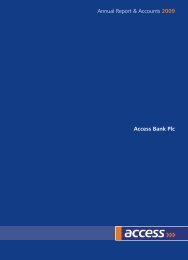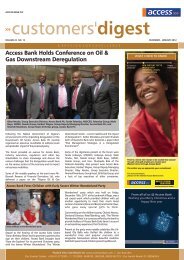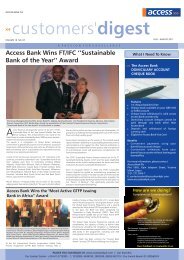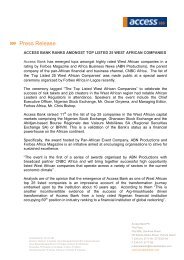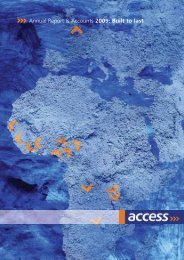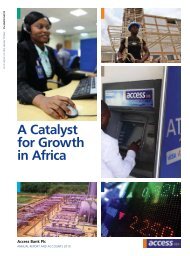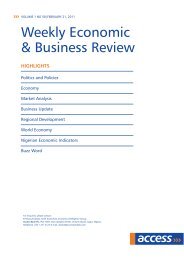Economic Weekly 02nd April 2013 - Access Bank
Economic Weekly 02nd April 2013 - Access Bank
Economic Weekly 02nd April 2013 - Access Bank
You also want an ePaper? Increase the reach of your titles
YUMPU automatically turns print PDFs into web optimized ePapers that Google loves.
VOLUME 3 NO 12 <strong>April</strong> 02, <strong>2013</strong><br />
Plot 999C Danmole street, Victoria Island Lagos,
VOLUME 3 NO 12 <strong>April</strong> 02, <strong>2013</strong><br />
CBN Extends Deadline for MFBs, Mortgage Institutions<br />
NEXIM <strong>Bank</strong> to Execute $60m Regional Sea-link Project.<br />
Update on Commodity Market<br />
Ivory Coast: IMF ups Ivory Coast <strong>2013</strong> growth forecast to 8%<br />
Burundi: Inflation Quickens to Near Double Digits in February<br />
U.K: UK <strong>Bank</strong>s Facing Capital Shortfall of £25 Billion, BoE Says<br />
U.S: U.S. Durable Goods Orders Jump 5.7% amid Surge in Aircraft Demand<br />
China: China and Brazil sign $30bn currency swap agreement<br />
Catch-up effect
VOLUME 3 NO 12 <strong>April</strong> 02, <strong>2013</strong><br />
CBN Extends Deadline for MFBs,<br />
Mortgage Institutions<br />
The Central <strong>Bank</strong> of Nigeria extended the deadline for compliance with the revised policy<br />
on regulation and supervisory framework for Microfinance <strong>Bank</strong>s (MFBs) to December<br />
31, <strong>2013</strong>. The deadline was initially set at December 31, 2012. The revision allows MFBs<br />
more time to raise capital or decide on the business combination options towards<br />
meeting the capital requirements for each category of MFB. Contained in the revised<br />
framework is capital requirement of N20 million for a unit Microfinance <strong>Bank</strong> authorized<br />
to operate in only one location. For a State Microfinance <strong>Bank</strong> authorized to operate in<br />
one State or the Federal Capital Territory (FCT) the capital requirement shall be a<br />
minimum paid-up capital of N100 million while National Microfinance <strong>Bank</strong> authorized<br />
to operate in more than one State including the FCT will have a minimum paid-up capital<br />
of N2 billion. MFBs are advised to conclude the processes of exercising options to meet<br />
the new capital requirement before the new deadline in order to allow sufficient time for<br />
capital verification and necessary regulatory approvals.
VOLUME 3 NO 12 <strong>April</strong> 02, <strong>2013</strong><br />
NEXIM <strong>Bank</strong> to Execute $60m<br />
Regional Sea-link Project.<br />
The Nigerian Export Import (NEXIM) <strong>Bank</strong> plans to execute a $60 million Regional Sealink<br />
Project for West and Central Africa. The purpose of the Sea-link project is to foster<br />
indigenous participation in the maritime sector. Also, it is expected to help facilitate<br />
intra-regional trade by supporting export diversification and deepening value added to<br />
non-oil exports. The project is expected to become profitable in the third year of<br />
commercial operations. The proposed regional sea-link project has been endorsed by<br />
the ECOWAS Commission with the regional body funding the project's Investors Forum.<br />
The scheme is also to cut across West and Central Africa ameliorating road transport<br />
infrastructure challenges that have slowed African and ECOWAS trade levels by 20%.
VOLUME 3 NO 12 March 25, <strong>2013</strong><br />
Market Analysis<br />
The Stock Market<br />
Performance indicator at the exchange closed on an impressive note for the 4-day<br />
trading period ended March 28, <strong>2013</strong>. The last week in Q1 <strong>2013</strong> was a bright one for<br />
stocks, supported by increased investor demand as sentiments stayed positive. The<br />
Nigeria Stock Exchange All Share Index (NSE ASI) closed higher by 0.09% at 33,536.24<br />
points while market capitalization gained N11.32billion and finished at N10.73 trillion.<br />
Encouraging financial scorecards released by some blue-chip companies boosted stock<br />
demand and prices. Equities are expected to continue along the upward trajectory on<br />
recent initiatives introduced to sustain interest in the market. The Asset Management<br />
Corporation of Nigeria (AMCON) is set to make some of its shares in banks (for which it<br />
presently manages) available for NSE securities lending. Further upswing is envisaged<br />
this week, as investors opt to lock-in on stocks believed to have strong market<br />
fundamental.<br />
1<br />
Source: NSE & <strong>Access</strong> <strong>Economic</strong> Intelligence<br />
Source: NSE & <strong>Access</strong> <strong>Economic</strong> Intelligence<br />
Chart 3: Stock Market Trend<br />
Source: NSE & <strong>Access</strong> <strong>Economic</strong> Intelligence
VOLUME 3 NO 12 <strong>April</strong> 02, <strong>2013</strong><br />
Market Analysis contd<br />
FGN Securities<br />
Increased activities at various maturity buckets in the bond market saw average bond<br />
yields moderated downwards for the week ended March 28, <strong>2013</strong>. The decline in<br />
average yields, more at the shorter tenor instruments was driven mainly by strong<br />
demand for government securities amid a relatively liquid money market. Increased<br />
investors' appetite for government securities as they sought for low risk assets also<br />
supported the observed trend. The <strong>Access</strong> <strong>Bank</strong> Government Bond Index recorded a<br />
further uptrend of 0.54% to close the week at 1,847.00 points. We expect this trend to<br />
continue on more robust demand this week, especially at the shorter end of the yield<br />
curve.<br />
Chart 4: Sovereign Bond Yield<br />
Source: NSE & <strong>Access</strong> <strong>Economic</strong> Intelligence<br />
NIBOR<br />
Last week, lending rates at the money market declined across maturities on relatively<br />
high liquidity levels. CBN Treasury bill sales of about N216 billion did little to affect<br />
systemic liquidity position. The market opened with about N503 billion, but closed the<br />
week ended March 28, <strong>2013</strong> with a surplus of about N585 billion. Liquidity boosters<br />
from maturing T-bills amounted to N433 billion but systemic ejections came from T-bill<br />
auctions (N90 billion PMA) and wDAS FX purchases (N93.45 billion). Open Buy Back<br />
(OBB) and overnight rates dropped to 10.15% and 10.25% from 10.25% and 10.75%,<br />
in that order. 90-day inter-bank lending rate also pared 0.83 percentage points to<br />
11.50% compared to last week figure. This week, anticipated outflows include about<br />
N50 billion at wDAS and over N100 billion in T-bills Primary Market Auction (PMA). With<br />
the market still relatively liquid and projected inflows of over N240 billion in maturing T-<br />
bills, rates may slightly stay southwards.<br />
Chart 5:NIBOR<br />
Source: FDHL & <strong>Access</strong> <strong>Economic</strong> Intelligence
VOLUME 3 NO 12 <strong>April</strong> 02, <strong>2013</strong><br />
Market Analysis contd<br />
Chart 6:NIBOR Trend<br />
Source: FDHL & <strong>Access</strong> <strong>Economic</strong> Intelligence<br />
Average Deposit and<br />
Lending Rates<br />
Average deposit and lending rates remained stable across all tenors for the week ended<br />
March 28, <strong>2013</strong>. The stability in rates can be attributed to the relative ease observed in<br />
market liquidity. This week, we do not anticipate any noticeable change in deposit and<br />
lending rates. Consequently, rates are expected to remain broadly unchanged.<br />
Chart 7:Deposit and Lending Rates<br />
Source: FMDA & <strong>Access</strong> <strong>Economic</strong> Intelligence
VOLUME 3 NO 12 <strong>April</strong> 02, <strong>2013</strong><br />
Market Analysis contd<br />
Foreign Exchange Market<br />
As market closure for the Easter Holiday, the Naira strengthened against the US dollar<br />
at the CBN window gaining 1 kobo to close at N155.75/US$. Interbank FX rate lost 35<br />
kobo to finish at N158.55/US$, even though month end dollar sales by oil majors<br />
temporarily helped Naira fortunes during the week. BDC and parallel FX rates did not<br />
change from levels recorded a week earlier. At the bi-weekly auction, the apex bank<br />
sold $576.6 million. This week, the Naira should appreciate in anticipation for more<br />
dollar sales from oil companies.<br />
Chart 8:N/$ Trend<br />
Source: CBN, FMDA & <strong>Access</strong> <strong>Economic</strong> Intelligence<br />
Chart 9:Naira Exchange Rates<br />
Source: CBN, FMDA & <strong>Access</strong> <strong>Economic</strong> Intelligence
VOLUME 3 NO 12 <strong>April</strong> 02, <strong>2013</strong><br />
Ivory Coast<br />
IMF ups Ivory Coast <strong>2013</strong> growth forecast to 8%<br />
The International Monetary Fund (IMF) revised upward Ivory Coast economic growth to<br />
8% in <strong>2013</strong> from previous forecast of 7% on signs of improving economic outlook. Years<br />
of political turmoil impeded growth in the French-speaking West African nation. GDP<br />
growth for 2012 was pegged at 9.8% as against previous estimate of 8.6%. Reforms<br />
embarked on by the government, pushing for heavy investment to revamp crumbling<br />
infrastructure boosted optimism. Ivory Coast defaulted on a 2032 Eurobond in early<br />
2011. It has however, resume payment of coupon after receiving over $4 billion in debt<br />
relief under the IMF-World <strong>Bank</strong> Heavily Indebted Poor Country (HIPC) scheme. Ivory<br />
Coast has since announced plans to issue $1.2 billion worth of domestic debt in <strong>2013</strong>.
VOLUME 3 NO 12 <strong>April</strong> 02, <strong>2013</strong><br />
Update on Commodity Market<br />
Most commodity prices traded up for the week ended March 28, <strong>2013</strong>. Crude oil prices<br />
closed at $106.60 per barrel, gaining 0.86% while natural gas prices rose by 1.66% to<br />
close at $4.05 per million british thermal units (mbtu) due to increased demand. The<br />
increase in oil prices was largely driven by higher demand for heating oil, while rising<br />
crude oil stockpiles in the U.S. and stronger dollar limited gains. Gold and silver prices<br />
added 0.92% and 0.10% to finish at $1,605.85 per ounce and $28.64, respectively. The<br />
recent news on Cyprus bailout plan, which is unlikely to satisfy EU and IMF officials may<br />
have contributed to the rally of safe haven investments and also dragged down the Euro.<br />
This week, the ongoing bearish sentiment towards the Euro may continue. This may<br />
likely boost the appeal for the precious metal as a store of value. Crude oil prices may<br />
further trend northward on increasing demand – winter effect.
VOLUME 3 NO 12 <strong>April</strong> 02, <strong>2013</strong><br />
U.K<br />
UK <strong>Bank</strong>s Facing Capital Shortfall of £25 Billion, BoE Says<br />
In the United Kingdom, lenders will have to raise £25 billion in extra capital by end-<strong>2013</strong><br />
to absorb potential loss from exposure to high-risk loan portfolios, a report released by<br />
the <strong>Bank</strong> of England (BoE) show. The capital deficit is a child of growing exposure of UK<br />
<strong>Bank</strong>s to the sovereign debt crisis in the Eurozone, the property market and other<br />
financial risks. Growth in Europe's third largest economy was revised downward to 0.6%<br />
in <strong>2013</strong> from previously estimated 1.2%, due to lingering sovereign debt crisis in the<br />
euro area – the country's main export destination. The outlook for 2014 was also<br />
lowered to 1.8% from 2%. Meanwhile, growth is seen expanding 2.3% in 2015, 2.7% in<br />
2016 and 2.8% in 2017, in that order.<br />
U.S<br />
U.S<br />
U.S. Durable Goods Orders Jump 5.7% amid Surge in Aircraft Demand<br />
New orders for manufactured durable goods in U.S. rose to 5.7% in February <strong>2013</strong> from<br />
a 3.8% decline recorded in the previous month. The bigger than expected increase in<br />
durable goods orders was largely due to a 21.7% jump in orders for transportation<br />
equipment. This comes on the heels of a 17.8% drop in January. Also, orders for<br />
commercial aircraft and parts soared by 95.3% after falling 24% the month before. The<br />
encouraging data from the manufacturing sector is a boost to the slow U.S economic<br />
growth and may quicken the pace of global recovery. The U.S. economy is projected to<br />
expand by 2% in <strong>2013</strong>. The world's largest economy contributed about 22% to world<br />
output in 2012.<br />
China<br />
China and Brazil sign $30bn currency swap agreement<br />
China and Brazil have signed a currency swap deal to ensure smooth bilateral trade and<br />
guard against upshot of future global financial crises. The pact allows the central banks<br />
of both economies to swap local currencies worth of $30 billion (190 billion Yuan or 60<br />
billion Reals). Aside being the world's second-largest economy, Beijing is also Brasília<br />
biggest trading partner. Trade relations between economies (China & Brazil) have grown<br />
robustly over the past few years, with volumes rising to about $75 billion in 2012 from<br />
$6.7 billion recorded in 2003. It is hoped that, the swap agreement would ensure<br />
increasing trade volumes between nations is sustained, even as financial crisis in the<br />
future hurt global liquidity.
VOLUME 3 NO 12 <strong>April</strong> 02, <strong>2013</strong><br />
13<br />
Chart 10: External Reserves & Crude Oil (Bonny Light) Price<br />
Source: CBN, EIA & <strong>Access</strong> <strong>Economic</strong> Intelligence<br />
Chart 11:Average NIBOR<br />
Source: FDHL& <strong>Access</strong> <strong>Economic</strong> Intelligence<br />
Chart 12:Average Deposit Rates<br />
Source: FDHL & <strong>Access</strong> <strong>Economic</strong> Intelligence
VOLUME 3 NO 12 <strong>April</strong> 02, <strong>2013</strong><br />
14<br />
Chart 13:Average Prime Lending Rate<br />
Source: FDHL & <strong>Access</strong> <strong>Economic</strong> Intelligence<br />
Chart 14: Trends in MPR, Inflation and NIBOR Call<br />
Source: NBS & <strong>Access</strong> <strong>Economic</strong> Intelligence<br />
Chart 15: GDP Growth Rate<br />
Source: NBS & <strong>Access</strong> <strong>Economic</strong> Intelligence
VOLUME 3 NO 12 <strong>April</strong> 02, <strong>2013</strong><br />
15<br />
Chart 16: Inflation Rate<br />
Source: NBS & <strong>Access</strong> <strong>Economic</strong> Intelligence
VOLUME 3 NO 12 <strong>April</strong> 02, <strong>2013</strong><br />
16<br />
Catch-up effect<br />
In financial economics, the term “catch-up-effect” explains states that poorer<br />
economies' per capita incomes will tend to grow faster than richer<br />
economies. As a result, the national income of poor countries usually<br />
catches up with that of rich nations. Developing countries have the potential<br />
to grow at a faster rate than developed countries as return on capital is<br />
usually stronger in poor countries. Increasing the amount of capital by only a<br />
small amount can produce huge gains in productivity. Furthermore, new<br />
technology may even allow developing countries to leap-frog over<br />
industrialised countries with older technology. This, at least, is the traditional<br />
economic theory.


